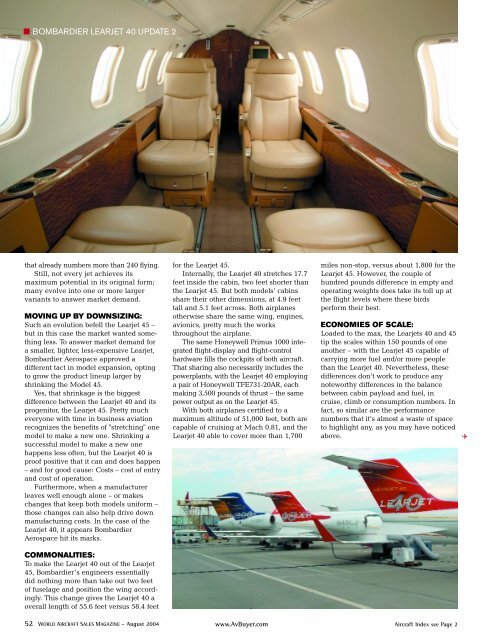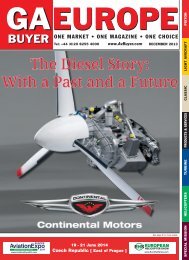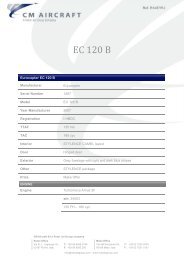BOMBARDIER LEARJET 40 - AvBuyer.com
BOMBARDIER LEARJET 40 - AvBuyer.com
BOMBARDIER LEARJET 40 - AvBuyer.com
You also want an ePaper? Increase the reach of your titles
YUMPU automatically turns print PDFs into web optimized ePapers that Google loves.
<strong>BOMBARDIER</strong> <strong>LEARJET</strong> <strong>40</strong> UPDATE 2<br />
that already numbers more than 2<strong>40</strong> flying.<br />
Still, not every jet achieves its<br />
maximum potential in its original form;<br />
many evolve into one or more larger<br />
variants to answer market demand.<br />
MOVING UP BY DOWNSIZING:<br />
Such an evolution befell the Learjet 45 –<br />
but in this case the market wanted something<br />
less. To answer market demand for<br />
a smaller, lighter, less-expensive Learjet,<br />
Bombardier Aerospace approved a<br />
different tact in model expansion, opting<br />
to grow the product lineup larger by<br />
shrinking the Model 45.<br />
Yes, that shrinkage is the biggest<br />
difference between the Learjet <strong>40</strong> and its<br />
progenitor, the Learjet 45. Pretty much<br />
everyone with time in business aviation<br />
recognizes the benefits of "stretching" one<br />
model to make a new one. Shrinking a<br />
successful model to make a new one<br />
happens less often, but the Learjet <strong>40</strong> is<br />
proof positive that it can and does happen<br />
– and for good cause: Costs – cost of entry<br />
and cost of operation.<br />
Furthermore, when a manufacturer<br />
leaves well enough alone – or makes<br />
changes that keep both models uniform –<br />
those changes can also help drive down<br />
manufacturing costs. In the case of the<br />
Learjet <strong>40</strong>, it appears Bombardier<br />
Aerospace hit its marks.<br />
COMMONALITIES:<br />
To make the Learjet <strong>40</strong> out of the Learjet<br />
45, Bombardier’s engineers essentially<br />
did nothing more than take out two feet<br />
of fuselage and position the wing accordingly.<br />
This change gives the Learjet <strong>40</strong> a<br />
overall length of 55.6 feet versus 58.4 feet<br />
for the Learjet 45.<br />
Internally, the Learjet <strong>40</strong> stretches 17.7<br />
feet inside the cabin, two feet shorter than<br />
the Learjet 45. But both models’ cabins<br />
share their other dimensions, at 4.9 feet<br />
tall and 5.1 feet across. Both airplanes<br />
otherwise share the same wing, engines,<br />
avionics, pretty much the works<br />
throughout the airplane.<br />
The same Honeywell Primus 1000 integrated<br />
flight-display and flight-control<br />
hardware fills the cockpits of both aircraft.<br />
That sharing also necessarily includes the<br />
powerplants, with the Learjet <strong>40</strong> employing<br />
a pair of Honeywell TFE731-20AR, each<br />
making 3,500 pounds of thrust – the same<br />
power output as on the Learjet 45.<br />
With both airplanes certified to a<br />
maximum altitude of 51,000 feet, both are<br />
capable of cruising at Mach 0.81, and the<br />
Learjet <strong>40</strong> able to cover more than 1,700<br />
miles non-stop, versus about 1,800 for the<br />
Learjet 45. However, the couple of<br />
hundred pounds difference in empty and<br />
operating weights does take its toll up at<br />
the flight levels where these birds<br />
perform their best.<br />
ECONOMIES OF SCALE:<br />
Loaded to the max, the Learjets <strong>40</strong> and 45<br />
tip the scales within 150 pounds of one<br />
another – with the Learjet 45 capable of<br />
carrying more fuel and/or more people<br />
than the Learjet <strong>40</strong>. Nevertheless, these<br />
differences don’t work to produce any<br />
noteworthy differences in the balance<br />
between cabin payload and fuel, in<br />
cruise, climb or consumption numbers. In<br />
fact, so similar are the performance<br />
numbers that it’s almost a waste of space<br />
to highlight any, as you may have noticed<br />
above.<br />
52 WORLD AIRCRAFT SALES MAGAZINE – August 2004 www.<strong>AvBuyer</strong>.<strong>com</strong><br />
Aircraft Index see Page 2<br />
✈






